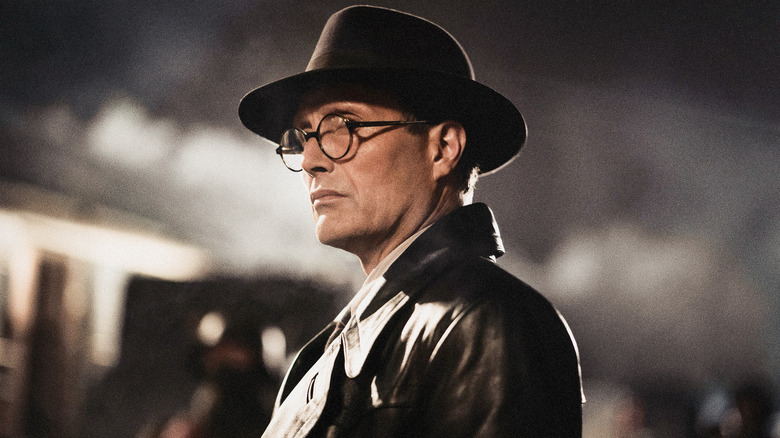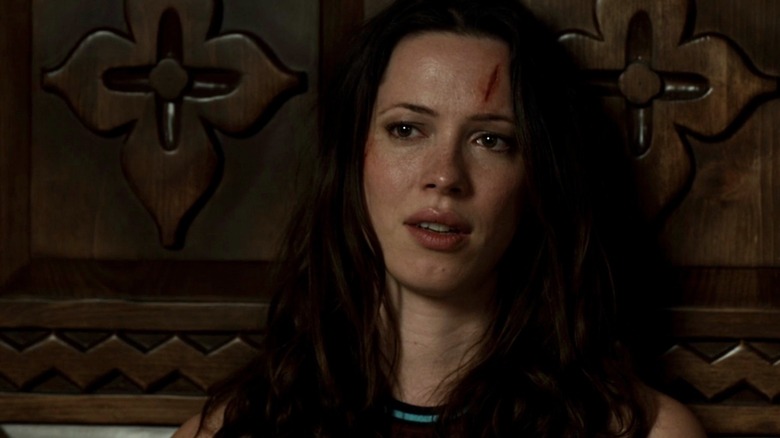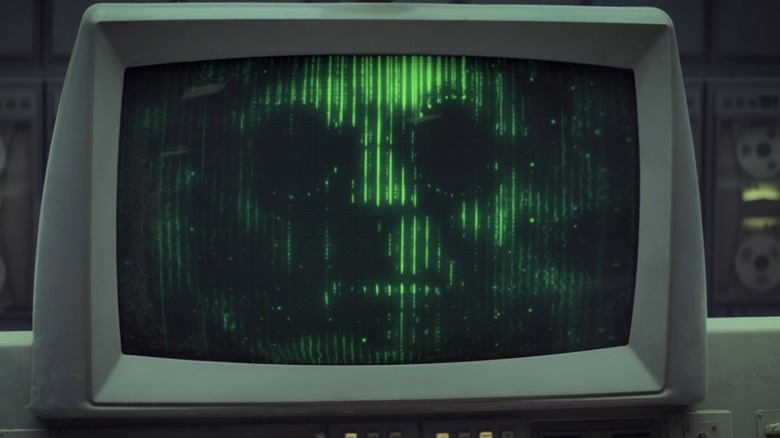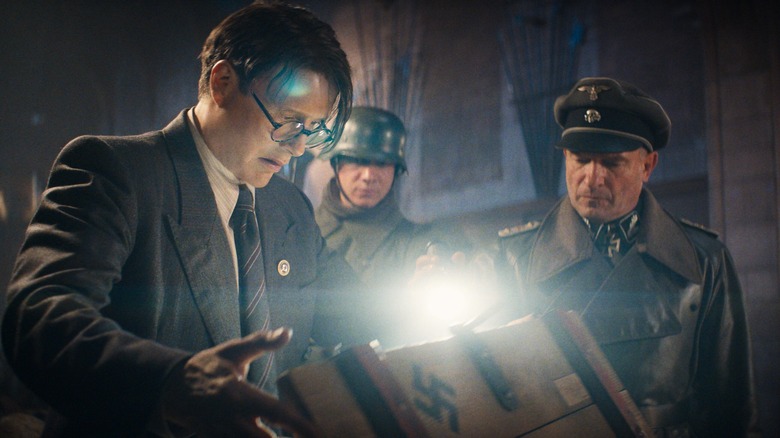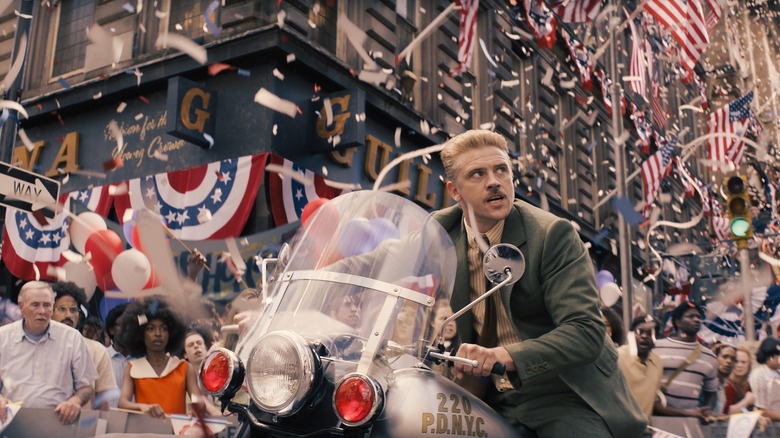Indiana Jones And The MCU Both Borrow The Same Piece Of Strange Real-World History
This post contains spoilers for "Indiana Jones and the Dial of Destiny."
In "Dial of Destiny," Indiana Jones, the movie son of James Bond, squares off against a Bond villain with a Nazi twist. His name is Jürgen Voller, and he's played by Mads Mikkelsen, who first rose to international fame in "Casino Royale." Here, Mikkelsen channels Wernher von Braun, the real-life German rocket scientist who went from being a Nazi Party member to an integral figure in the U.S. arms race and space race with the Soviet Union.
In that respect, "Dial of Destiny" is a little late to the party. From the Marvel Cinematic Universe to streaming shows like "Hunters" and "For All Mankind," Hollywood has been on a von Braun kick the last few years, perhaps because America — in its self-mythology through pop culture — is still reckoning with the fact that it allowed a Nazi into NASA and put him on both the cover of Time Magazine and the TV show that became "The Wonderful World of Disney."
Not for nothing, but in its early scenes, "Dial of Destiny" feels a bit like an MCU film or a latter-day "Star Wars" movie, complete with squint-inducing night scenes to obscure the slithery quality of its visual effects. The franchise has done an action set piece aboard a train before (see: "Indiana Jones and the Last Crusade"), but in this case, River Phoenix gives way to a digitally de-aged Harrison Ford, while the "Nazi plunder train" feels cut from the cloth of "Captain America: The First Avenger" and "Solo: A Star Wars Story."
In the end, these are all Disney movies ("Dial of Destiny" notably begins with the words, "Disney and Lucasfilm present," a franchise first), so it's not surprising that they might share some of the same DNA, including Wernher von Braun.
Jürgen Voller, Wernher von Braun, and Iron Man 3
There's a robust tradition of Indiana Jones punching (and melting) Nazis, and that continues with the Toht-esque Jürgen Voller in "Dial of Destiny." Voller, like Indy, identifies the Lance of Longinus, the "blade that drew Christ's blood," as a fake, whereupon the movie trades another potential Judeo-Christian artifact (after the Ark of the Covenant and Holy Grail) for a sci-fi MacGuffin: the time-traveling Archimedes Dial.
When it jumps to 1969, with Old Man Jones living in New York on the day of the Apollo 11 moon landing, "Dial of Destiny" brushes up against scientific fact. At one point, the henchman Klaber (Boyd Holbrook) explains that Voller, in his new American identity as Professor Schmidt, was the engineer responsible for building the rocket that put the astronauts on the moon. This is the clearest indication that Voller is based on Wernher von Braun.
The first MCU reference to von Braun came 10 years ago in "Iron Man 3." It happens about halfway through the movie, in a scene where the inventor of Extremis, Maya Hansen (Rebecca Hall, role reduced because of merchandising concerns), sits on the bed talking to Pepper Potts (Gwyneth Paltrow). Just a minute before the Extremis-powered villain Aldrich Killian (Guy Pearce) bursts in and she's revealed as his accomplice, Maya says to Pepper:
"Fun fact. Before he built rockets for the Nazis, the idealistic Wernher von Braun dreamed of space travel. He stargazed. Do you know what he said when the first V-2 hit London? 'The rocket performed perfectly. It just landed on the wrong planet.'"
In real life, von Braun did lead the V-2's development before the Nazis used it as a ballistic missile and vengeance weapon ("V" is for "vengeance") on London and other Allied cities.
Operation Paperclip and The Winter Soldier
NASA itself notes that the V-2 helped carry the first human-made object into space, and it "was developed by Wernher von Braun's team of German researchers, who surrendered to the United States at the end of World War II." If you're wondering how those researchers (and Nazis) wound up working for NASA — with von Braun achieving celebrity status — it happened through Operation Paperclip. As the Smithsonian's National Air and Space Museum notes, this secret intelligence program sought "to exploit German science and technology" for U.S. purposes.
In 2014, the year "Captain America: The Winter Soldier" hit theaters, The New York Times likened von Braun, his fellow Nazi scientists, and their research to U.S. war trophies. The full extent of Operation Paperclip only became public knowledge with the declassification of military files decades later. Like the Thuggees in "Indiana Jones and the Temple of Doom," the Nazis used slave labor. Their concentration camps helped build von Braun's rockets.
"The Winter Soldier" mentions Operation Paperclip when Steve Rogers (Chris Evans) and Natasha Romanoff (Scarlett Johansson) find that Cap's old WWII enemy, Arnim Zola (Toby Jones), is "alive" as a present-day supercomputer in a hidden S.H.I.E.L.D. bunker. Zola, who helped the evil Hydra infiltrate S.H.I.E.L.D., says he was "invited" to the U.S. because his "mind was worth saving." Natasha further explains: "It was Operation Paperclip. After World War II, S.H.I.E.L.D. recruited German scientists with strategic value."
"They thought I could help their cause," Zola adds. "I also helped my own." Jürgen Voller hatches a similar plot in "Dial of Destiny." Jones (Toby, not Indy) also shows up as Indy's ally, Basil Shaw, who is driven as crazy by the Archimedes Dial as John Hurt was by the Crystal Skull.
Hunters, For All Mankind, and Dial of Destiny
"Indiana Jones and the Dial of Destiny" shares another connection with "Captain America: The Winter Soldier," in that they both feature German actor Thomas Kretschmann. In "The Winter Soldier," Kretschmann appears mid-credits as the Hydra leader, Baron Wolfgang von Strucker. In "Dial of Destiny," he plays Colonel Weber, the Nazi who questions Basil Shaw after he's caught posing as a bird-watcher. This time, Kretschmann and Toby Jones are on opposite sides, with Weber hailing Hitler instead of Hydra.
"The Winter Soldier" wouldn't be the last time prior to "Dial of Destiny" that Wernher von Braun worked his way into a piece of entertainment. In the first season of the Prime Video series "Hunters," a band of Nazi hunters, led by Al Pacino, catch up with von Braun (Victor Slezak) after he has faked his death in 1977. They learn through interrogation that von Braun has been aiding the Fourth Reich's world domination plans from within the U.S. so that he can have the moon and "rule the stars." That's a job Pacino would entrust to someone else when he "gave Harrison Ford his career" by declining the role of Han Solo in "Star Wars."
Colm Feore plays another alternate-history version of von Braun in a few early episodes of the Apple TV+ series "For All Mankind," where the respected NASA leader's Nazi past is eventually exposed at a congressional hearing. What's most scary about von Braun, his trigger-happy henchmen, and what they represent in "Dial of Destiny" is the idea that there are some monsters in American society who haven't been exposed, and who are, like Hydra, hiding in plain sight, ready for the President to award them medals in their creased business suits.
Stars, stripes, and swastikas
"People tend to romanticize science when it is, in fact, quite cold," Jürgen Voller observes in "Indiana Jones and the Dial of Destiny." The same could be said for American movies romanticizing American history at the expense of uglier truths.
Indiana Jones is as much a national icon as Captain America himself, and when he comes face to face with Archimedes (Nasser Memarzia), it's as if the new Roman Empire is meeting the old one, prior to its collapse. If there's any justifiable reason for killing off the Black CIA agent, Mason (Shaunette Renée Wilson), in "Dial of Destiny," maybe it's just to show how quickly things can spiral out of control when the American government gets into bed with Nazis. (S.H.I.E.L.D. learned that lesson with Hydra all too well.)
"Dial of Destiny" positions Indy's goddaughter, Helena Shaw (Phoebe Waller-Bridge), as his co-lead; hers is the last face onscreen before the film irises out on Indy's hand grabbing his signature fedora hat. Helena is a self-assured model of the new Lucasfilm lady, like a grown-up version of young Leia from the Disney+ series "Obi-Wan Kenobi." She's also a proud capitalist who's out to get what hers, regardless of the collateral damage. (R.I.P. Antonio Banderas.)
As a corporate cash grab from the Mouse House, the best one could say about "Dial of Destiny" is that it's a serviceable sequel, balancing out the Indiana Jones series with another 21st-century sci-fi flick centered on Old Man Jones. Yet as a cultural relic, not unlike the artifacts Indy raids, "Dial of Destiny" also now rests within the same trove as "The Winter Soldier" and other screen narratives that have used Uncle Sam's real entanglements with Nazis — on U.S. soil — as window dressing. Probably not a good interior decoration idea, America, to mix stars and stripes with swastikas.
